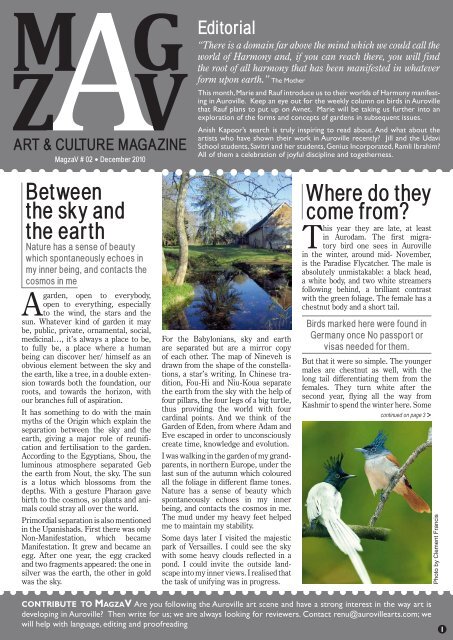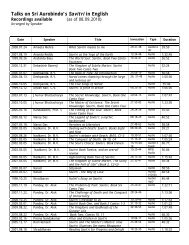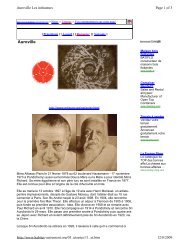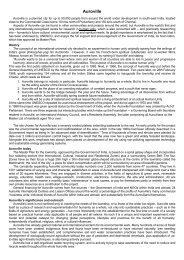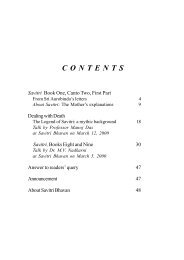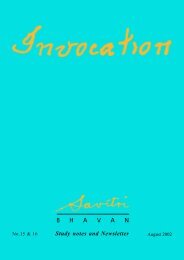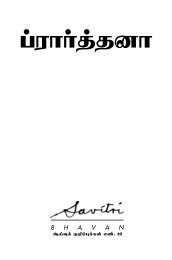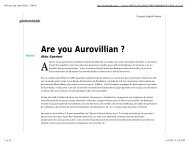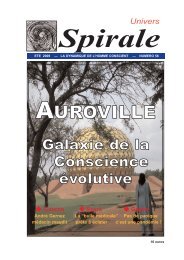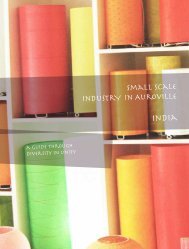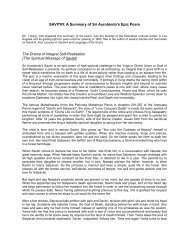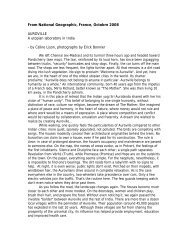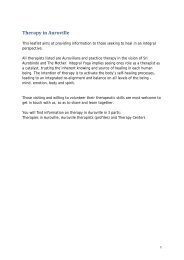Between the sky and the earth Where do they come from? - Auroville
Between the sky and the earth Where do they come from? - Auroville
Between the sky and the earth Where do they come from? - Auroville
You also want an ePaper? Increase the reach of your titles
YUMPU automatically turns print PDFs into web optimized ePapers that Google loves.
MagzaV # 02 • December 2010<br />
<strong>Between</strong><br />
<strong>the</strong> <strong>sky</strong> <strong>and</strong><br />
<strong>the</strong> <strong>earth</strong><br />
Nature has a sense of beauty<br />
which spontaneously echoes in<br />
my inner being, <strong>and</strong> contacts <strong>the</strong><br />
cosmos in me<br />
A<br />
garden, open to everybody,<br />
open to everything, especially<br />
to <strong>the</strong> wind, <strong>the</strong> stars <strong>and</strong> <strong>the</strong><br />
sun. Whatever kind of garden it may<br />
be, public, private, ornamental, social,<br />
medicinal…, it’s always a place to be,<br />
to fully be, a place where a human<br />
being can discover her/ himself as an<br />
obvious element between <strong>the</strong> <strong>sky</strong> <strong>and</strong><br />
<strong>the</strong> <strong>earth</strong>, like a tree, in a <strong>do</strong>uble extension<br />
towards both <strong>the</strong> foundation, our<br />
roots, <strong>and</strong> towards <strong>the</strong> horizon, with<br />
our branches full of aspiration.<br />
It has something to <strong>do</strong> with <strong>the</strong> main<br />
myths of <strong>the</strong> Origin which explain <strong>the</strong><br />
separation between <strong>the</strong> <strong>sky</strong> <strong>and</strong> <strong>the</strong><br />
<strong>earth</strong>, giving a major role of reunification<br />
<strong>and</strong> fertilisation to <strong>the</strong> garden.<br />
According to <strong>the</strong> Egyptians, Shou, <strong>the</strong><br />
luminous atmosphere separated Geb<br />
<strong>the</strong> <strong>earth</strong> <strong>from</strong> Nout, <strong>the</strong> <strong>sky</strong>. The sun<br />
is a lotus which blossoms <strong>from</strong> <strong>the</strong><br />
depths. With a gesture Pharaon gave<br />
birth to <strong>the</strong> cosmos, so plants <strong>and</strong> animals<br />
could stray all over <strong>the</strong> world.<br />
Primordial separation is also mentioned<br />
in <strong>the</strong> Upanishads. First <strong>the</strong>re was only<br />
Non-Manifestation, which became<br />
Manifestation. It grew <strong>and</strong> became an<br />
egg. After one year, <strong>the</strong> egg cracked<br />
<strong>and</strong> two fragments appeared: <strong>the</strong> one in<br />
silver was <strong>the</strong> <strong>earth</strong>, <strong>the</strong> o<strong>the</strong>r in gold<br />
was <strong>the</strong> <strong>sky</strong>.<br />
Editorial<br />
“There is a <strong>do</strong>main far above <strong>the</strong> mind which we could call <strong>the</strong><br />
world of Harmony <strong>and</strong>, if you can reach <strong>the</strong>re, you will find<br />
<strong>the</strong> root of all harmony that has been manifested in whatever<br />
form upon <strong>earth</strong>.” The Mo<strong>the</strong>r<br />
This month, Marie <strong>and</strong> Rauf introduce us to <strong>the</strong>ir worlds of Harmony manifesting<br />
in <strong>Auroville</strong>. Keep an eye out for <strong>the</strong> weekly column on birds in <strong>Auroville</strong><br />
that Rauf plans to put up on Avnet. Marie will be taking us fur<strong>the</strong>r into an<br />
exploration of <strong>the</strong> forms <strong>and</strong> concepts of gardens in subsequent issues.<br />
Anish Kapoor’s search is truly inspiring to read about. And what about <strong>the</strong><br />
artists who have shown <strong>the</strong>ir work in <strong>Auroville</strong> recently? Jill <strong>and</strong> <strong>the</strong> Udavi<br />
School students, Savitri <strong>and</strong> her students, Genius Incorporated, Ramli Ibrahim?<br />
All of <strong>the</strong>m a celebration of joyful discipline <strong>and</strong> toge<strong>the</strong>rness.<br />
For <strong>the</strong> Babylonians, <strong>sky</strong> <strong>and</strong> <strong>earth</strong><br />
are separated but are a mirror copy<br />
of each o<strong>the</strong>r. The map of Nineveh is<br />
drawn <strong>from</strong> <strong>the</strong> shape of <strong>the</strong> constellations,<br />
a star’s writing. In Chinese tradition,<br />
Fou-Hi <strong>and</strong> Niu-Koua separate<br />
<strong>the</strong> <strong>earth</strong> <strong>from</strong> <strong>the</strong> <strong>sky</strong> with <strong>the</strong> help of<br />
four pillars, <strong>the</strong> four legs of a big turtle,<br />
thus providing <strong>the</strong> world with four<br />
cardinal points. And we think of <strong>the</strong><br />
Garden of Eden, <strong>from</strong> where Adam <strong>and</strong><br />
Eve escaped in order to unconsciously<br />
create time, knowledge <strong>and</strong> evolution.<br />
I was walking in <strong>the</strong> garden of my gr<strong>and</strong>parents,<br />
in nor<strong>the</strong>rn Europe, under <strong>the</strong><br />
last sun of <strong>the</strong> autumn which coloured<br />
all <strong>the</strong> foliage in different flame tones.<br />
Nature has a sense of beauty which<br />
spontaneously echoes in my inner<br />
being, <strong>and</strong> contacts <strong>the</strong> cosmos in me.<br />
The mud under my heavy feet helped<br />
me to maintain my stability.<br />
Some days later I visited <strong>the</strong> majestic<br />
park of Versailles. I could see <strong>the</strong> <strong>sky</strong><br />
with some heavy clouds reflected in a<br />
pond. I could invite <strong>the</strong> outside l<strong>and</strong>scape<br />
into my inner views. I realised that<br />
<strong>the</strong> task of unifying was in progress.<br />
<strong>Where</strong> <strong>do</strong> <strong>the</strong>y<br />
<strong>come</strong> <strong>from</strong>?<br />
This year <strong>the</strong>y are late, at least<br />
in Aurodam. The first migratory<br />
bird one sees in <strong>Auroville</strong><br />
in <strong>the</strong> winter, around mid- November,<br />
is <strong>the</strong> Paradise Flycatcher. The male is<br />
absolutely unmistakable: a black head,<br />
a white body, <strong>and</strong> two white streamers<br />
following behind, a brilliant contrast<br />
with <strong>the</strong> green foliage. The female has a<br />
chestnut body <strong>and</strong> a short tail.<br />
Birds marked here were found in<br />
Germany once No passport or<br />
visas needed for <strong>the</strong>m.<br />
But that it were so simple. The younger<br />
males are chestnut as well, with <strong>the</strong><br />
long tail differentiating <strong>the</strong>m <strong>from</strong> <strong>the</strong><br />
females. They turn white after <strong>the</strong><br />
second year, flying all <strong>the</strong> way <strong>from</strong><br />
Kashmir to spend <strong>the</strong> winter here. Some<br />
continued on page 3 ><br />
CONTRIBUTE TO Ma g z a V Are you following <strong>the</strong> <strong>Auroville</strong> art scene <strong>and</strong> have a strong interest in <strong>the</strong> way art is<br />
developing in <strong>Auroville</strong>? Then write for us; we are always looking for reviewers. Contact renu@aurovillearts.com; we<br />
will help with language, editing <strong>and</strong> proofreading<br />
Photo by Clement Francis<br />
1
2<br />
AUROVILLE ART & CULTURE MAGAZINE MagzaV # 02 • December 2010<br />
Anish Kapoor<br />
The world renowned artist, Anish Kapoor, is having his first ever<br />
exhibition in India <strong>from</strong> <strong>the</strong> end of November 2010 upto <strong>the</strong> end of<br />
January 2011. For those who are new to his work, here are a few<br />
excerpts <strong>from</strong> interviews<br />
Is it my role as an artist to say something,<br />
to express, to be expressive? I<br />
think it’s my role as an artist to bring<br />
to expression, it’s not my role to be<br />
expressive. I’ve got nothing particular<br />
to say, I <strong>do</strong>n’t have any message to give<br />
anyone. But it is my role to bring to<br />
expression, let’s say, to define means<br />
that allow phenomenological <strong>and</strong><br />
o<strong>the</strong>r perceptions which one might<br />
use, one might work with, <strong>and</strong> <strong>the</strong>n<br />
move towards a poetic existence.”<br />
Anish Kapoor<br />
“ Is it my role as an artist to say<br />
something, to<br />
„<br />
express, to be<br />
expressive ?<br />
Homi K Bhabha, in his essay on Kapoor<br />
(Anish Kapoor: Making Emptiness)<br />
quotes him, saying: “I believe very<br />
deeply that works of art, or let’s say<br />
things in <strong>the</strong> world, not just works of<br />
art, can be truly made. If <strong>the</strong>y are truly<br />
made, in <strong>the</strong> sense of possessing <strong>the</strong>mselves,<br />
<strong>the</strong>n <strong>the</strong>y are beautiful. If <strong>the</strong>y are<br />
not truly made, <strong>the</strong> eye is a very quick<br />
<strong>and</strong> very good instrument… The idea<br />
of <strong>the</strong> truly made <strong>do</strong>es not only have<br />
to <strong>do</strong> with truth. It has to <strong>do</strong> with <strong>the</strong><br />
meeting of material <strong>and</strong> non-material…<br />
[A] thing exists in <strong>the</strong> world because<br />
it has mythological, psychological <strong>and</strong><br />
philosophical coherence. That is when a<br />
thing is truly made…”<br />
In a conversation with Marcello Dantas,<br />
Kapoor comments on <strong>the</strong> purpose of<br />
art: “The art that I admire <strong>do</strong>es something<br />
more than tell my little psycho<br />
biographical story, who’s interested? We<br />
are here for a few minutes, <strong>and</strong> <strong>the</strong>n we<br />
are dead. If art is to endure it must have<br />
to <strong>do</strong> with much more than that. Now<br />
maybe <strong>the</strong> only way we can get to bigger<br />
subjects is through psychobiography.<br />
I hate formalism, because formalism<br />
implies a death of <strong>the</strong> subject <strong>and</strong> <strong>the</strong><br />
subject is <strong>the</strong> only reason to be an artist.<br />
Not that I have something to say, I have<br />
nothing to say, <strong>the</strong> whole reason to be<br />
an artist in fact is to uncover, in <strong>the</strong><br />
process of working, some deeper truth.<br />
As Bruce Nauman said, <strong>the</strong> artist reveals<br />
deep mystic truth, but to reveal deep<br />
mystic truths implies that one knows<br />
what <strong>the</strong>y are, <strong>the</strong> point is that one <strong>do</strong>es<br />
not know what <strong>the</strong>y are, an artist may<br />
stumble upon <strong>the</strong>m maybe?”<br />
“ •••<strong>the</strong><br />
whole reason to be<br />
an artist in fact is to uncover,<br />
in <strong>the</strong> process of working,<br />
some deeper truth...„<br />
In an interview with John Tusa, Kapoor<br />
talks of how an artist looks for content:<br />
“One of <strong>the</strong> currents in <strong>the</strong> contemporary<br />
experience of art is that it points to<br />
<strong>the</strong> experience of <strong>the</strong> author. That is to<br />
say it dwells in <strong>the</strong> author. It seems to<br />
me that <strong>the</strong>re’s ano<strong>the</strong>r route in which<br />
<strong>the</strong> artist looks for content, which is different<br />
<strong>from</strong> meaning. It may be abstract,<br />
but at a deeper level symbolic content<br />
is necessarily philosophical <strong>and</strong> often<br />
religious. I think I am attempting to dig<br />
away at - without wanting to sound too<br />
pompous - <strong>the</strong> great mystery of being.<br />
And that, while it has a route through<br />
my psychobiography, it isn’t based in it.”<br />
According to <strong>the</strong> website of <strong>the</strong><br />
National Gallery of Modern Art,<br />
http://ngmaindia.gov.in<br />
The exhibitions will be displayed in two<br />
venues: <strong>the</strong> newly renovated NGMA,<br />
New Delhi (Anish Kapoor show will<br />
be <strong>the</strong> first major exhibition to be held<br />
in <strong>the</strong> gallery’s newly constructed Exhibition<br />
Hall); <strong>and</strong> <strong>the</strong> Mehboob film<br />
studios, B<strong>and</strong>ra, Mumbai. Each exhibition<br />
will focus on a different str<strong>and</strong> of<br />
Kapoor’s practice, with each show complementing<br />
<strong>the</strong> o<strong>the</strong>r to form an overall<br />
picture of <strong>the</strong> diversity <strong>and</strong> energy<br />
within his oeuvre. Both exhibitions will<br />
feature works which were included in<br />
<strong>the</strong> recent, record-breaking exhibition<br />
of Kapoor’s work at <strong>the</strong> Royal Academy,<br />
Lon<strong>do</strong>n, which attracted over 275,000<br />
visitors in less than three months. The<br />
Anish Kapoor exhibitions will coincide<br />
with <strong>the</strong> India Art Summit, which runs<br />
<strong>from</strong> 20-23 January 2011, <strong>and</strong> attracts<br />
approximately 40,000 visitors annually.<br />
Who paints?<br />
I Paint<br />
And <strong>the</strong> world reveals itself to me.<br />
I Paint<br />
And I forget who is painting.<br />
I Paint<br />
And Light seeps in through <strong>the</strong><br />
darkness.<br />
I Paint<br />
And I am life <strong>and</strong> Life is me.<br />
I Paint<br />
Who Paints?<br />
Photo by Till Niermann
AUROVILLE ART & CULTURE MAGAZINE MagzaV # 02 • December 2010<br />
<strong>Where</strong> <strong>do</strong> <strong>the</strong>y <strong>come</strong> <strong>from</strong>?<br />
> continued <strong>from</strong> page 1<br />
creatures (like myself) will <strong>do</strong> anything<br />
to avoid cold!<br />
It gets even more bizarre. There is a<br />
resident variety in which <strong>the</strong> male never<br />
turns white. They even nest in <strong>Auroville</strong>.<br />
So if you see a white bird with a long tail,<br />
you can be sure it’s <strong>from</strong> <strong>the</strong> Himalayas<br />
<strong>and</strong> older than three years.<br />
If it’s brown, it’s ei<strong>the</strong>r a young Himalayan<br />
bird, or a South Indian bird. To see<br />
what <strong>the</strong>se various phases look like, go<br />
to: http://orientalbirdimages.org/search.<br />
php?Bird_ID=2222.<br />
The o<strong>the</strong>r bird that usually <strong>come</strong>s<br />
early is <strong>the</strong> Forest Wagtail. A long, slim<br />
bird, slightly larger than a sparrow, it<br />
has black <strong>and</strong> white mottling on <strong>the</strong><br />
wings <strong>and</strong> a long tail. Wagtails, most of<br />
whom are migrants, wag <strong>the</strong>ir tails up<br />
<strong>and</strong> <strong>do</strong>wn. This one wags its tail sideways,<br />
see http://orientalbirdimages.org/<br />
search.php?Bird_ID=2091 . It breeds in<br />
Assam <strong>and</strong> East Asia, <strong>and</strong> is supposed<br />
to only pass through here; but it’s seen<br />
all winter.<br />
Going a few kilometres <strong>from</strong> here to <strong>the</strong><br />
birding paradise of Kalivelli tank, <strong>the</strong><br />
most conspicuous are <strong>the</strong> huge flocks<br />
of ducks: Common teal, Pintail, Shoveller,<br />
Wigeon, Common Pochard. Most<br />
of <strong>the</strong>se breed in Siberia. The occasional<br />
Barheaded Goose, visiting us <strong>from</strong> <strong>the</strong><br />
high altitude lakes of Ladakh, is also<br />
seen. Geese are funny: <strong>the</strong>y shed all<br />
<strong>the</strong>ir fea<strong>the</strong>rs at <strong>the</strong> same time <strong>the</strong>y<br />
have this urge to migrate. So <strong>the</strong>y start<br />
walking! They walk <strong>and</strong> swim huge distances<br />
until <strong>the</strong>ir fea<strong>the</strong>rs grow back,<br />
<strong>and</strong> <strong>the</strong>y can fly again.<br />
Also in large numbers are <strong>the</strong> different<br />
waders: s<strong>and</strong>pipers, plovers, shanks, <strong>and</strong><br />
stints. They look similar to each o<strong>the</strong>r,<br />
<strong>and</strong> need some practice to tell apart.<br />
Probably <strong>the</strong> most conspicuous are <strong>the</strong><br />
White Storks. They <strong>come</strong> rarely, having<br />
a long way to travel. Birds marked here<br />
were found in Germany once. No passport<br />
or visas needed for <strong>the</strong>m.<br />
The list of migrants goes into <strong>the</strong> hundreds.<br />
The best way to learn about <strong>the</strong>m<br />
is to get a bird book <strong>and</strong> start looking.<br />
OTO.3<br />
On <strong>the</strong> 8th of January 2011, Holger (electric violin) will perform in <strong>Auroville</strong><br />
with Maarten Visser (saxophone) <strong>and</strong> Robbert Van Hulzen (drums).<br />
Holger <strong>and</strong> Maarten Visser, <strong>the</strong> composer, have been working for months to<br />
get this toge<strong>the</strong>r. The concert will last about 1 1/2 hours during which <strong>the</strong> performers<br />
will regularly explain what is happening musically so that <strong>the</strong> audience<br />
can closely follow. Those who wish can take part in an informal artist-audience<br />
interaction after <strong>the</strong> show.<br />
The idea behind OTO.3 is to create experimental, sound based music with<br />
some references to existing musical styles. The structures, ideas <strong>and</strong> development<br />
in sound are set. Maarten Visser takes <strong>the</strong> open scores to <strong>the</strong> musicians<br />
<strong>and</strong> through <strong>the</strong>ir interaction a piece will be created that may be very different<br />
<strong>from</strong> <strong>the</strong> original idea <strong>and</strong> concept. The musicians enjoy ample space to create<br />
<strong>the</strong>ir own musical tracks, manipulate <strong>the</strong> score <strong>and</strong> give <strong>the</strong>mselves to open<br />
improvisation. The music has a constant tension between sound <strong>and</strong> silence,<br />
notes <strong>and</strong> noise, <strong>and</strong> structure <strong>and</strong> free<strong>do</strong>m.<br />
8th of January in <strong>Auroville</strong>! Not to be missed...<br />
Keep an eye out for <strong>the</strong> venue announcement.<br />
OTO.3 will perform at Aurodhan Gallery on <strong>the</strong> 7th, at Cholam<strong>and</strong>al Artists’<br />
Village on <strong>the</strong> 9th, <strong>and</strong> in Chennai on <strong>the</strong> 10th.<br />
Pascal suggests, interesting musicians you can google on internet :<br />
Anthony Braxton • Ellery Eskelin • John Zorn • Tim Berne • Mat<strong>the</strong>w Shipp •<br />
Jean-Michel Pilc • Jackie Byard<br />
<strong>Auroville</strong> Promenade<br />
Early November<br />
this year, Holger<br />
Jetter <strong>and</strong> Léonard<br />
Siméon, performed<br />
toge<strong>the</strong>r in Bremen,<br />
Germany.<br />
‘<strong>Auroville</strong> Promenade’<br />
was an audiovisual<br />
show, in<br />
which Holger <strong>and</strong><br />
Léonard interacted<br />
with each o<strong>the</strong>r on<br />
stage. Léonard used<br />
computer animations<br />
<strong>and</strong> a light-mixer to visualize <strong>the</strong><br />
improvised music that Holger played<br />
on a six-string electric violin.<br />
<strong>Auroville</strong> Promenade is <strong>the</strong> subjective<br />
view of <strong>the</strong> two artists on a personal<br />
journey through <strong>the</strong>ir daily lives in<br />
<strong>the</strong>ir home town, <strong>from</strong> dawn till<br />
evening. Holger <strong>and</strong> Léonard take a<br />
walk, passing <strong>from</strong><br />
<strong>the</strong> ocean through<br />
surrounding villages,<br />
through different<br />
aspects <strong>and</strong> perceptions<br />
of <strong>the</strong> city,<br />
into a wonderful<br />
world of forests. On<br />
<strong>the</strong> way <strong>the</strong>y meet<br />
markets, schools<br />
<strong>and</strong> new forms of<br />
architecture, at<br />
times halting <strong>the</strong>ir<br />
journey to focus on<br />
details for a while.<br />
Sometimes <strong>the</strong>y lose <strong>the</strong>mselves in<br />
<strong>the</strong> greatness of <strong>the</strong> l<strong>and</strong>scape, <strong>and</strong><br />
towards evening <strong>the</strong>y reach Matrim<strong>and</strong>ir,<br />
<strong>the</strong> centre of <strong>the</strong>ir city.<br />
Through <strong>the</strong> artists’ creative vision<br />
<strong>the</strong> audience was invited to a parallel<br />
universe of abstract forms <strong>and</strong> less<br />
known layers of daily life.<br />
3
4<br />
AUROVILLE ART & CULTURE MAGAZINE MagzaV # 02 • December 2010<br />
Comedy Calls<br />
Older but no wiser<br />
funny as hell<br />
One must love to smile, love to<br />
laugh, love to see crazy antics on<br />
stage, unabashedly, unashamedly crazy<br />
stuff, to love <strong>the</strong> latest incarnation<br />
of <strong>the</strong> Genius Bro<strong>the</strong>rs, i.e., Genius<br />
Incorporated. And who <strong>do</strong>esn’t?<br />
Older but no wiser, funny as hell, <strong>the</strong>se<br />
3 mayhem makers – Wazo, Paul <strong>and</strong><br />
Jesse - ran amok on <strong>the</strong> VC stage Friday<br />
night in one of <strong>the</strong> best shows ever<br />
<strong>from</strong> <strong>the</strong> trio, helped un<strong>do</strong>ubtedly by<br />
Mahi with <strong>the</strong> absolutely essential <strong>and</strong><br />
beautiful, minimalist lighting design<br />
<strong>and</strong> <strong>the</strong> wizardry of Christoph whosupplied<br />
<strong>the</strong> visuals <strong>and</strong> provided<br />
depth <strong>and</strong> inventive animation to <strong>the</strong><br />
performance.<br />
In <strong>the</strong> great tradition of political-social<br />
satire, <strong>the</strong>se 3 stage veterans brought to<br />
our kind attention <strong>the</strong> values of marathon<br />
running in your own home, how<br />
to get work <strong>do</strong>ne amidst incredible<br />
Review of<br />
Kimkini<br />
KIMKINI - Sanskrit for<br />
a dancer’s anklets<br />
Savitri is celebrating tonight, <strong>the</strong> 23rd<br />
of October, <strong>and</strong> with her she brings<br />
friends that share her passion for dance<br />
<strong>and</strong> her students <strong>from</strong> various surrounding<br />
villages.<br />
The evening starts slowly as <strong>the</strong> Auditorium<br />
fills up with many young Tamil<br />
chaos, as well as <strong>the</strong> value of friendship<br />
<strong>and</strong> <strong>the</strong> stupidity of bureaucracy, not<br />
a bad haul for one night. Even if <strong>the</strong>re<br />
were some scenes which were a tad too<br />
long, going on pointless after <strong>the</strong> point<br />
had been made … well, no one’s perfect!<br />
And <strong>the</strong>y’re never bee known for<br />
<strong>the</strong>ir editing. If it’s a question of editing<br />
as opposed to wringing <strong>the</strong> humor dry,<br />
<strong>the</strong>y’ll always go for dry humor.<br />
Lasting 1 ½ hours, in front of a packed<br />
house, <strong>the</strong> tightly knit show had no<br />
major glitches, one minor technical<br />
problem, quickly covered up, as <strong>the</strong><br />
three juggled dialogue, clever repartee<br />
<strong>and</strong> asides, visuals, physical humor <strong>and</strong><br />
just plain silly stuff with ease.<br />
Why is it always three: Think <strong>the</strong> Marx<br />
Bro<strong>the</strong>rs. Think <strong>the</strong> Three Stooges,<br />
Think …. Well, when you stop thinking,<br />
you’ll realize that three’s <strong>the</strong> magic<br />
number for <strong>come</strong>dy. Why? Beats me.<br />
NO, but wait, <strong>the</strong>re’s <strong>the</strong> Wiki, who has<br />
all <strong>the</strong> answers.<br />
“The rule of three is a principle in writing<br />
that suggests that things that <strong>come</strong> in<br />
ians? C<strong>and</strong>les are lit <strong>and</strong> lamps glow,<br />
reflecting on <strong>the</strong> photos of Mo<strong>the</strong>r <strong>and</strong><br />
Sri Aurobin<strong>do</strong> that are put on stage.<br />
threes are inherently funnier, more<br />
satisfying, or more effective than<br />
o<strong>the</strong>r numbers of things. The reader/<br />
audience to this form of text is also<br />
more likely to consume information<br />
if it is written in groups of threes.<br />
From slogans (“Go, fight, win!”) to<br />
films, many things are structured<br />
in threes. There were three musketeers,<br />
three little pigs, three billy goats<br />
Gruff, Goldilocks <strong>and</strong> <strong>the</strong> three bears,<br />
three blind mice <strong>and</strong> three Stooges.<br />
A series of three is often used to create<br />
a progression in which <strong>the</strong> tension<br />
is created, <strong>the</strong>n built up, <strong>and</strong> finally<br />
released. Similarly, adjectives are often<br />
grouped toge<strong>the</strong>r in threes to emphasize<br />
an idea.<br />
In <strong>come</strong>dy, it is suggested that maximum<br />
humor can be attained by creating<br />
a structure in which a joke is set<br />
up, <strong>the</strong> setup is reinforced, <strong>and</strong> <strong>the</strong><br />
punchline breaks <strong>the</strong> pattern.<br />
• How <strong>do</strong> you get to my place?<br />
Go <strong>do</strong>wn to <strong>the</strong> corner, turn left, <strong>and</strong><br />
get lost.<br />
• I know three French words:<br />
Bonjour, merci, <strong>and</strong> surrender.<br />
The rule of three in <strong>come</strong>dy also<br />
reflects a principle of pattern recognition<br />
because a set of three elements has<br />
<strong>the</strong> smallest number of elements that<br />
can establish <strong>and</strong> violate a pattern.”<br />
OK. Genius Incorporated, in <strong>the</strong><br />
footsteps of Seneca, Terence <strong>and</strong> The<br />
Goon Show are our priceless answer<br />
to stuffed shirts, egos <strong>and</strong> pomposity.<br />
Long may <strong>the</strong>y rain <strong>the</strong>ir humor <strong>do</strong>wn<br />
upon us.<br />
of <strong>the</strong> evening, accompanied by soft<br />
<strong>and</strong> strong steps <strong>and</strong> quivering, hovering<br />
gestures like butterflies in a race<br />
to complete each item. It is as if that’s<br />
<strong>the</strong> necklace on which Savitri has strung<br />
this very elaborate program toge<strong>the</strong>r.<br />
Sweetness radiates <strong>from</strong> <strong>the</strong> innocence<br />
children, where are <strong>the</strong> o<strong>the</strong>r Aurovil-<br />
Finally <strong>the</strong> show begins with four beautiful<br />
women dancing <strong>the</strong> ‘ pushpa anjali’,<br />
inaugurating <strong>the</strong> space <strong>and</strong> setting <strong>the</strong><br />
atmosphere.<br />
A sweet feminine voice is <strong>the</strong> red thread<br />
<strong>and</strong> eagerness which all <strong>the</strong> girls put<br />
continued on page 6 >
AUROVILLE ART & CULTURE MAGAZINE MagzaV # 02 • December 2010<br />
Male Matters<br />
The Buddha-like energy is<br />
filling <strong>the</strong> space...<br />
Nine male dancers charged <strong>the</strong> stage<br />
of <strong>the</strong> Sri Aurobin<strong>do</strong> Auditorium<br />
on <strong>the</strong> 20th of October, creating trinities<br />
of Odissi, Bharatanatyam <strong>and</strong>, <strong>from</strong><br />
In<strong>do</strong>nesia, a contemporary fusion of<br />
Javanese <strong>and</strong> Butoh dance languages.<br />
Three male dancers <strong>from</strong> <strong>the</strong> Rudrakshya<br />
Dance Foundation (Orissa) began <strong>the</strong><br />
evening weaving <strong>the</strong> feminine rounded<br />
curves <strong>and</strong> waves of <strong>the</strong> Odissi language,<br />
gradually progressing with a masculine<br />
vitality into a solo rendition of <strong>the</strong> battle<br />
of Karna <strong>from</strong> <strong>the</strong> Mahabharatha epic.<br />
A beautiful dancer, strongly rooted to<br />
<strong>earth</strong>, mastering <strong>the</strong> Odissi language with<br />
full poise, battled on stage sending hundreds<br />
of arrows out into all directions of<br />
<strong>the</strong> suddenly-too-small auditorium. A<br />
hero who gave his breast plate, cutting<br />
open his chest, to <strong>the</strong> oppositional forces<br />
<strong>and</strong> who, till <strong>the</strong> end, kept faithful to <strong>the</strong><br />
gods’ merciless play of forces, dying with<br />
<strong>the</strong> arrows piercing his bare chest whilst<br />
heaving his chariot wheel out of <strong>the</strong><br />
ear<strong>the</strong>n clay! How dance is able to revive<br />
<strong>the</strong> energy of such play of forces is once<br />
again proven <strong>and</strong> <strong>the</strong> stage is left desolate<br />
empty <strong>and</strong> estranged.<br />
But only to be filled by yet ano<strong>the</strong>r trio,<br />
this time <strong>from</strong> Malaysia’s Sutra Dance<br />
Theatre. They divided into duets <strong>and</strong><br />
solos to depict <strong>the</strong> dark blue hues of<br />
Krishna while reverently referring to his<br />
original form as Vishnu.<br />
Here <strong>the</strong> Bharathanatyam language, so<br />
soon after <strong>the</strong> fluidity of Odissi, strikes<br />
<strong>and</strong> baffles us with its square energy,<br />
its cross-like lines into space, its almost<br />
mask-like face in <strong>the</strong> solo of Ibrahim<br />
Ramli, <strong>and</strong> its seemingly angry stamping<br />
of <strong>the</strong> <strong>earth</strong>.<br />
The stage looks too large <strong>and</strong> <strong>the</strong> dancers<br />
seem to drown as <strong>the</strong>y move back <strong>and</strong><br />
forth, towards <strong>and</strong> away, <strong>from</strong> an imaginary<br />
front line; shoulders tensed <strong>and</strong><br />
faces glued to <strong>the</strong> audience. But <strong>the</strong>n,<br />
each time <strong>the</strong> arms pass through space<br />
- cutting it, almost slicing it into halves<br />
...we cannot but marvel at<br />
<strong>the</strong> intelligence that lies<br />
within this sacred art<br />
The body is glorified <strong>and</strong><br />
<strong>the</strong>n given to simple mockery<br />
<strong>and</strong> quarters, stretching <strong>the</strong> circumference<br />
around <strong>the</strong> dancers’ bodies - we<br />
cannot but marvel at <strong>the</strong> intelligence<br />
that lies within this sacred art. It’s a ritual<br />
movement, connecting time to <strong>the</strong> very<br />
moment of one breath! And all three<br />
dancers be<strong>come</strong> <strong>the</strong> embodiment of<br />
Krishna.<br />
And again it seems as though <strong>the</strong> stage<br />
dies in front of us, its hollowness echoing<br />
emptily to awaken within minutes to yet<br />
a new dawn. Yes, literally <strong>the</strong> sounds fill<br />
<strong>the</strong> stuffy air with <strong>the</strong> fresh life of sweet<br />
harmonies <strong>and</strong> <strong>the</strong> cackling-pecking of<br />
chickens. Is it early morning already or is<br />
it really late at night? Roosters crowing?<br />
No, not even..or...?<br />
A duet by In<strong>do</strong>nesia’s Dew<strong>and</strong>aru Dance<br />
Company unfolds. Faces are covered by<br />
straw hats folded around <strong>the</strong> ears <strong>and</strong><br />
held tight around <strong>the</strong> chin; it’s no longer<br />
about <strong>the</strong> face. It’s <strong>the</strong> body that speaks.<br />
Held <strong>do</strong>wn in a deep squat, shuffling over<br />
an imaginary dew-filled forest ground,<br />
with torsos contracted, arms suspended,<br />
curved like <strong>the</strong> wings of birds, creating<br />
staccato movements, <strong>the</strong>n rolling <strong>from</strong><br />
<strong>the</strong> shoulder joint all <strong>the</strong> way to <strong>the</strong> fingers<br />
that resemble antennas; swaying <strong>and</strong><br />
searching <strong>the</strong> atmosphere with lightening<br />
speed. Two bodies capture our full<br />
attention, agile, strong, in tune with each<br />
o<strong>the</strong>r. All memories of <strong>the</strong> feminine are<br />
erased by a strong instinctual, animal-like<br />
humanness. The audience seems spellbound<br />
as <strong>the</strong> dancers show us <strong>the</strong> rawness<br />
of our nature, our hunger, curiosity<br />
<strong>and</strong> disgust, with emotional vital energies<br />
surging through <strong>the</strong>ir bodies, skilfully<br />
blending mysterious Javanese gestures<br />
with <strong>the</strong> contorted spasms <strong>and</strong> contractions<br />
of <strong>the</strong> Butoh language. Yet all <strong>the</strong>se<br />
find <strong>the</strong>ir flight in a string of contemporary<br />
jumps <strong>and</strong> rolls, - <strong>the</strong> monkey in us<br />
is released... The body is glorified <strong>and</strong><br />
<strong>the</strong>n given to simple mockery. The black<br />
backdrop splits open <strong>and</strong> a third dancer<br />
<strong>come</strong>s on stage, completing once again<br />
<strong>the</strong> trinity energy of <strong>the</strong> evening. The<br />
serenity of his face is no longer a mask,<br />
but a tool to remind us of our connection<br />
to <strong>the</strong> serene inner space of introspection<br />
<strong>and</strong> contemplation. The Buddha-like<br />
energy is filling <strong>the</strong> space...<br />
This last dance of <strong>the</strong> evening sends us<br />
out into <strong>the</strong> night wondering, amazed<br />
<strong>and</strong> charmed by its direct indirectness.<br />
There remains just one question: Was it<br />
all a Male Matter?<br />
5
AUROVILLE ART & CULTURE MAGAZINE MagzaV # 02 • December 2010<br />
Review of Kimkini<br />
> continued <strong>from</strong> page 4<br />
into <strong>the</strong>ir roles, <strong>and</strong> <strong>from</strong> <strong>the</strong>ir sense of<br />
solidarity. The dances are announced<br />
in Tamil <strong>and</strong> sometimes in English <strong>and</strong><br />
<strong>the</strong> repertoire is a typical of such Aurovilian<br />
events. “Nothing is really new or<br />
surprising, just entertaining”.<br />
Savitri’s Bharatanatyam solo is graceful<br />
<strong>and</strong> light; she shows her professional<br />
attitude towards <strong>the</strong> stage in spite of<br />
losing her dance anklet <strong>and</strong> being sloppy<br />
with <strong>the</strong> attachment of jewellery; she<br />
maintains a sweet girlish stamina <strong>and</strong><br />
reveals a short burst of <strong>the</strong> strength,<br />
which she still needs to develop in order<br />
to be<strong>come</strong> <strong>the</strong> truthful character she<br />
wishes to inhabit in her dance.<br />
Then enters Masha with Michael<br />
Jackson moves: how <strong>do</strong>es this fit<br />
Savitri – a soul for any age<br />
The director had cleverly <strong>and</strong> boldly<br />
interpreted three Savitri figures<br />
On November 6th at <strong>the</strong> Bharat Nivas<br />
Auditorium, <strong>the</strong> Young Flame Theatre<br />
Company <strong>from</strong> Udavi School in Edayanchavadi<br />
village performed an interpretation<br />
of Savitri, Sri Aurobin<strong>do</strong>’s epic<br />
poem with text <strong>from</strong> <strong>the</strong> Mahabharata.<br />
Jill, <strong>the</strong> director, had cleverly, <strong>and</strong> boldly,<br />
interpreted three Savitri figures. One was<br />
Savitri <strong>the</strong> contemporary school girl, one<br />
<strong>the</strong> Savitri <strong>from</strong> <strong>the</strong> poem, <strong>and</strong> <strong>the</strong> third<br />
one <strong>the</strong> “Spirit of Savitri”. Their stories<br />
are interwoven as <strong>the</strong> three girls search<br />
for love – human <strong>and</strong> divine.<br />
The school girl Savitri, whose mo<strong>the</strong>r has<br />
into <strong>the</strong> program? She is followed by<br />
Droupad in a solo that reveals <strong>the</strong> joy of<br />
dance, perhaps transferred by <strong>the</strong> magical<br />
hat of Michael Jackson that Masha<br />
has dropped on stage for Droupad to<br />
pick up. Droupad ends face <strong>do</strong>wn, on<br />
his belly, <strong>and</strong> Savitri <strong>come</strong>s on stage to<br />
dance upon his back. She looks fierce in<br />
a beautiful way <strong>and</strong> sure of herself !<br />
The evening ends with a freely chosen<br />
mix of Bharatanatyam, Filmy <strong>and</strong><br />
Kathak dance movements; all <strong>the</strong> girls<br />
show how much joy <strong>the</strong>y experience in<br />
dancing <strong>and</strong> being toge<strong>the</strong>r on stage.<br />
Savitri has shown us that she has developed<br />
into a grounded dancer <strong>and</strong><br />
teacher-cum-choreographer. There was<br />
whistling <strong>and</strong> cheering for all on stage<br />
<strong>and</strong> Savitri, breathless, received blessings<br />
<strong>from</strong> her teachers <strong>and</strong> dance guru.<br />
died, worries about her social life <strong>and</strong><br />
being unattractive to boys. Her fa<strong>the</strong>r,<br />
Aswapathy, a math’s teacher, tries to<br />
console her, but she seeks comfort with<br />
her auntie. She meets her Satyavan, first<br />
glimpsed through a thicket hedge, <strong>and</strong><br />
eventually all works out well as <strong>the</strong>y fall<br />
in love.<br />
The real Savitri of <strong>the</strong> poem seeks for<br />
truth <strong>and</strong> follows Yama, <strong>the</strong> God of<br />
Death, into <strong>the</strong> underworld.<br />
It was lovely to hear <strong>the</strong> familiar Savitri<br />
lines such as, “And <strong>earth</strong>ly life be<strong>come</strong>s<br />
<strong>the</strong> life divine”, spoken by <strong>the</strong>se young<br />
people. Jill had given <strong>the</strong>m <strong>the</strong> opportunity<br />
to immerse <strong>the</strong>ir minds in <strong>the</strong><br />
beauty of Savitri over a six month<br />
rehearsal period in <strong>the</strong>ir drama classes at<br />
Udavi School.<br />
The kids were underst<strong>and</strong>ably very<br />
nervous on that expanse of stage. The<br />
performance opened with each one introducing<br />
<strong>the</strong>ir character – <strong>the</strong>n rushing<br />
off-stage as quickly as possible to <strong>the</strong><br />
security of <strong>the</strong> darkness behind. Some<br />
had large chunks of Savitri to memorize,<br />
<strong>and</strong> English is not <strong>the</strong>ir first language.<br />
After <strong>the</strong>ir nervous start <strong>the</strong>y began to<br />
relax <strong>and</strong> <strong>the</strong>ir diction was good.<br />
Jill had <strong>the</strong> ingenious idea to be actively<br />
part of <strong>the</strong> play <strong>and</strong>, dressed in a long<br />
classic white dress, was actually part of<br />
<strong>the</strong> performance. She was <strong>the</strong> narrator<br />
<strong>and</strong> walked on <strong>and</strong> off stage announcing<br />
each scene – Act One, Scene One, etc.<br />
This gave coherence to <strong>the</strong> play <strong>and</strong><br />
must have given a very wel<strong>come</strong> feeling<br />
of security to <strong>the</strong> young, inexperienced<br />
actors.<br />
A beautiful dance scene in front of King<br />
Aswapathy <strong>and</strong> Princess Savitri, choreographed<br />
by Kanchana, gave <strong>the</strong> kids<br />
a break <strong>from</strong> <strong>the</strong>ir recitations. The costumes<br />
by Upasana Design Studio were<br />
excellent <strong>and</strong> Jean’s lighting good.<br />
It was a heartwarming performance <strong>from</strong><br />
an inexperienced group of students on<br />
that huge Bharat Nivas stage.<br />
SUPPORT • SUPPORT • SUPPORT Like many in <strong>Auroville</strong>, we work with love, talent, determination <strong>and</strong> little else.<br />
Support MagzaV by making a small recurring contribution of Rs. 100/- per month to our account # 251282<br />
Send an email to : financialservice@auroville.org.in. • THANK YOU IN ADVANCE<br />
6<br />
The contributors to <strong>the</strong> contents of this issue of MagzaV are : Alon, Batel, Dianna, Gerard, Giorgio, Grace, Holger, Hufreesh, Jill, Krishna, Marco, Marie, Mauna, Miniature, Pascal, Rauf, Renu, Taj


